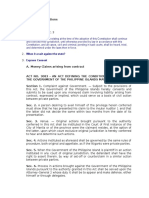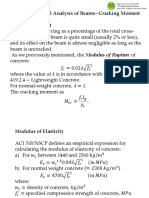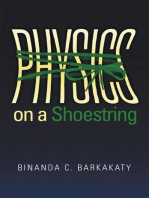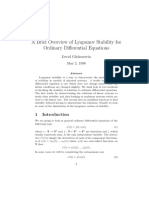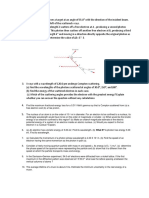Kinetics of Particles
Kinetics of Particles
Uploaded by
Khen VillanuevaCopyright:
Available Formats
Kinetics of Particles
Kinetics of Particles
Uploaded by
Khen VillanuevaOriginal Description:
Original Title
Copyright
Available Formats
Share this document
Did you find this document useful?
Is this content inappropriate?
Copyright:
Available Formats
Kinetics of Particles
Kinetics of Particles
Uploaded by
Khen VillanuevaCopyright:
Available Formats
1
All figures taken from Vector Mechanics for Engineers: Dynamics, Beer
and Johnston, 2004
ENGR 214
Chapter 12
Kinetics of Particles:
Newtons Second Law
2
Newtons Second Law of Motion
If the resultant force acting on a particle is not
zero, the particle will have an acceleration
proportional to the magnitude of resultant and
in the direction of the resultant.
We must use a Newtonian frame of reference, i.e., one that is
not accelerating or rotating.
If no force acts on particle, particle will not accelerate, i.e., it will
remain stationary or continue on a straight line at constant
velocity.
F ma =
If particle is subjected to several forces:
F ma =
3
Linear Momentum of a Particle
( )
( )
dv
F ma m
dt
d d
mv L
dt dt
= =
= =
L mv = Linear momentum
F L =
Sum of forces = rate of change of linear momentum
0 F =
If
linear momentum is constant
Principle of conservation of linear momentum
4
Equations of Motion
Newtons second law a m F
Convenient to resolve into components:
( ) ( )
z m F y m F x m F
ma F ma F ma F
k a j a i a m k F j F i F
z y x
z z y y x x
z y x z y x
= = =
= = =
+ + = + +
For tangential and normal components:
2
t t n n
t n
F ma F ma
dv v
F m F m
dt
= =
= =
5
Dynamic Equilibrium
Alternate expression of Newtons law:
0 F ma =
If we include inertia vector, the system of
forces acting on particle is equivalent to
zero. The particle is said to be in
dynamic equilibrium.
Inertia vectors are often called inertia
forces as they measure the resistance
that particles offer to changes in
motion.
ma inertia vector
6
Sample Problem 12.2
An 80-kg block rests on a horizontal plane. Find
the magnitude of the force P required to give the
block an acceleration of 2.5 m/s
2
to the right. The
coefficient of kinetic friction between the block and
plane is
k
= 0.25.
SOLUTION:
Draw a free body diagram
Apply Newtons law. Resolve
into rectangular components
7
Sample Problem 12.2
80 9.81 785
0.25
k
W mg N
F N N
= = =
= =
: ma F
x
=
( )( )
cos30 0.25 80 2.5
200
P N =
=
: 0 =
y
F
sin30 785 0 N P =
( )
sin30 785
cos30 0.25 sin30 785 200
N P
P P
= +
+ =
534.7 P N =
Pcos30
Psin30
Solve for P and N
1052.4 N N =
8
Sample Problem 12.3
The two blocks shown start from rest.
The horizontal plane and the pulley are
frictionless, and the pulley is assumed to
be of negligible mass. Determine the
acceleration of each block and the
tension in the cord.
9
Sample Problem 12.3
x A A
F m a =
( )
1
100
A
T a =
y B B
F m a =
( )
( )
2
2
2
300 9.81 300
2940- 300
B B B
B
B
m g T m a
T a
T a
=
=
=
y C C
F m a =
0 2
1 2
= T T
x
y
O
Kinematic relationship: If A moves x
A
to the right, B moves down 0.5 x
A
1 1
2 2 B A B A
x x a a = =
Draw free body diagrams & apply Newtons law:
( )
1
2940- 300 2 0
B
a T =
( )
2940- 300 200 0
B A
a a =
( )
2940- 300 2 200 0
B B
a a =
2
4.2 /
B
a m s =
2
8.4 /
A
a m s =
1
840 T N =
2
1680 T N =
10
Sample Problem 12.4
The 12-lb block B starts from rest and slides
on the 30-lb wedge A, which is supported by
a horizontal surface.
Neglecting friction, determine (a) the
acceleration of the wedge, and (b) the
acceleration of the block relative to the
wedge.
Block
Wedge
11
N
1
a
Bn
a
Bt
W
B
cosu
W
B
sinu
N
1
W
B
N
1
cosu
N
1
sinu
sin
B B Bt
W m a u =
2
12
12 0.5 16.1 /
32.2
Bt Bt
a a ft s = =
a
A
1
sin
A A
N m a u =
1
30
0.5
32.2
A
N a =
1 2
cos
A
N W N u + =
1
cos
B B Bn
N W m a u =
But
sin
Bn A
a a u =
Same normal acceleration (to maintain contact)
1
cos sin
B B A
N W m a u u =
1
12 0.5
10.39
32.2
A
N a
=
2
5.08 /
A
a ft s =
2
2.54 /
Bn
a ft s =
Draw free body diagrams for block & wedge
12
N
1
a
Bn
a
Bt
W
B
cosu
W
B
sinu
N
1
W
B
N
1
cosu
N
1
sinu
2
cos sin 12.67 /
Bx Bt Bn
a a a ft s u u = =
a
A
2
sin cos 10.25 /
By Bt Bn
a a a ft s u u = + =
/ B A B A
a a a =
( ) ( )
/
12.67 10.25 5.08
17.75 10.25
B A
a i j i
i j
=
= 20.5
30
13
Sample Problem 12.5
The bob of a 2-m pendulum describes an arc of a circle in a
vertical plane. If the tension in the cord is 2.5 times the
weight of the bob for the position shown, find the velocity
and acceleration of the bob in that position.
14
Sample Problem 12.5
Resolve into tangential and normal components:
:
t t
ma F =
=
=
30 sin
30 sin
g a
ma mg
t
t
2
s m 9 . 4 =
t
a
:
n n
ma F =
( ) =
=
30 cos 5 . 2
30 cos 5 . 2
g a
ma mg mg
n
n
2
s m 03 . 16 =
n
a
Solve for velocity in terms of normal acceleration.
( )( )
2
2
s m 03 . 16 m 2 = = =
n n
a v
v
a
s m 66 . 5 = v
mgsin30
mgcos30
15
Sample Problem 12.6
Determine the rated speed of a
highway curve of radius = 400 ft
banked through an angle u = 18
o
. The
rated speed of a banked highway curve
is the speed at which a car should
travel if no lateral friction force is to
be exerted at its wheels.
SOLUTION:
The car travels in a horizontal circular
path with a normal component of
acceleration directed toward the center
of the path.The forces acting on the car
are its weight and a normal reaction
from the road surface.
Resolve the equation of motion for
the car into vertical and normal
components.
Solve for the vehicle speed.
16
Sample Problem 12.6
SOLUTION:
The car travels in a horizontal circular
path with a normal component of
acceleration directed toward the center
of the path.The forces acting on the
car are its weight and a normal
reaction from the road surface.
Resolve the equation of motion for
the car into vertical and normal
components.
: 0 =
y
F
u
u
cos
0 cos
W
R
W R
=
=
:
n n
ma F =
u
u
u
2
sin
cos
sin
v
g
W W
a
g
W
R
n
=
=
Solve for the vehicle speed.
( )( ) =
=
18 tan ft 400 s ft 2 . 32
tan
2
2
u g v
h mi 1 . 44 s ft 7 . 64 = = v
17
Angular Momentum
O
H r mv =
Derivative of angular momentum with respect to time:
O
O
H r mv r mv v mv r ma
r F
M
= + = +
=
=
Sum of moments about O = rate of change of angular momentum
and r mv
L mv =
From before, linear momentum:
Now angular momentum is defined as the moment of momentum
O
H is a vector perpendicular to the plane
containing
Resolving into radial & transverse components:
2
O
H mv r mr
u
u = =
Moment of about O F
18
Equations of Motion in Radial & Transverse Components
( )
( ) u u
u
u u
r r m ma F
r r m ma F
r r
2
2
+ = =
= =
19
Central Force
When force acting on particle is directed
toward or away from a fixed point O, the
particle is said to be moving under a
central force.
Since line of action of the central force passes through O:
0
O O
M H = =
constant
O
r mv H = =
O = center of force
20
Sample Problem 12.7
A block B of mass m can slide freely on
a frictionless arm OA which rotates in a
horizontal plane at a constant rate .
0
u
a) the component v
r
of the velocity of B
along OA, and
b) the magnitude of the horizontal force
exerted on B by the arm OA.
Knowing that B is released at a distance
r
0
from O, express as a function of r
SOLUTION:
Write the radial and transverse
equations of motion for the block.
Integrate the radial equation to find an
expression for the radial velocity.
Substitute known information into the
transverse equation to find an
expression for the force on the block.
21
Sample Problem 12.7
Write radial and transverse
equations of motion:
r r
F m a
F m a
u u
=
=
dr
dv
v
dt
dr
dr
dv
dt
dv
v r
r
r
r r
r
= = = =
( )
2 2 2 2
0 0 r
v r r u =
( )
1 2
2 2 2
0 0
2 F m r r u =
( )
( )
2
0
2
m r r
F m r r
u
u u
=
= +
2
r ru =
But
r
v r =
2
r
r
dv
r v
dr
u =
2
r r
r dr v dv u =
2
0
r
o
v
r
r r o
r
v dv r dr u =
} }
( )
1 2
2 2
0 0 r
v r r u =
You might also like
- IFEM HW01 Sol Ch02Document3 pagesIFEM HW01 Sol Ch02halcyon304No ratings yet
- KINETICS Practice Problems and SolutionsDocument9 pagesKINETICS Practice Problems and SolutionsnairdanipsoNo ratings yet
- Lecture 3 - Kinetics of Particles Energy and Momentum MethodsDocument32 pagesLecture 3 - Kinetics of Particles Energy and Momentum MethodsKeu JiannRong0% (2)
- Design PavementDocument10 pagesDesign PavementarianneNo ratings yet
- Section 3. All Courts Existing at The Time of The Adoption of This Constitution Shall ContinueDocument11 pagesSection 3. All Courts Existing at The Time of The Adoption of This Constitution Shall ContinueKarizsaHatabNo ratings yet
- ECS448 - Topic 5 (Deformation - Virtual Work For Frame & Truss)Document33 pagesECS448 - Topic 5 (Deformation - Virtual Work For Frame & Truss)darwishshahrir__No ratings yet
- Business - Opportunity - Identificationbusiness Opportunity IdentificationDocument8 pagesBusiness - Opportunity - Identificationbusiness Opportunity IdentificationSneha Elizabeth VivianNo ratings yet
- MODULE 1 - Intro To Structural Steel DesignDocument10 pagesMODULE 1 - Intro To Structural Steel DesignGail Nathalie LiraNo ratings yet
- GTEL01E: Physical Properties of Soil: Modules inDocument14 pagesGTEL01E: Physical Properties of Soil: Modules inHatsuieeNo ratings yet
- Materials Exam March 10 2007Document2 pagesMaterials Exam March 10 2007Elvin G. TactacNo ratings yet
- C1 TechnopreneurshipDocument54 pagesC1 TechnopreneurshipAqibNo ratings yet
- CE231 Course SyllabusDocument4 pagesCE231 Course SyllabusAlyfer del Rosario100% (1)
- Module 3 STRUCTURAL THEORY MidtermDocument15 pagesModule 3 STRUCTURAL THEORY MidtermMatet MaglipacNo ratings yet
- Module 5 GENERAL PROVISIONS ON LAW ON CONTRACTS - CodalsDocument3 pagesModule 5 GENERAL PROVISIONS ON LAW ON CONTRACTS - CodalsIsaiah John Domenic M. CantaneroNo ratings yet
- Module 2: Labor Computation: MobilizationDocument33 pagesModule 2: Labor Computation: Mobilizationapriljoy angelesNo ratings yet
- Curvature and RefractionDocument48 pagesCurvature and RefractionErrichamae AiranNo ratings yet
- Prestressed Concrete LECTURE 1 PDFDocument41 pagesPrestressed Concrete LECTURE 1 PDFRenz Olex M. Canlas100% (1)
- DOLES v. ANGELES G.R. No. 149353. June 26, 2006Document2 pagesDOLES v. ANGELES G.R. No. 149353. June 26, 2006SSNo ratings yet
- Ce Laws NotesDocument2 pagesCe Laws NotesasdasasdsdfsdfNo ratings yet
- Lecture 7 - Analysis of Indeterminate Structures - Exact Methods-1Document29 pagesLecture 7 - Analysis of Indeterminate Structures - Exact Methods-1Mary Dominique OnateNo ratings yet
- Prestressed ConcreteDocument8 pagesPrestressed ConcreteYeswanth RaghavendraNo ratings yet
- Construction and Materials Testing (Lecture and Lab) SyllabusDocument9 pagesConstruction and Materials Testing (Lecture and Lab) SyllabusLino Angelo DimaculanganNo ratings yet
- Study Guide - Strength of MaterialsDocument5 pagesStudy Guide - Strength of MaterialsEj ParañalNo ratings yet
- TDocument491 pagesTJelminda AlfaroNo ratings yet
- 2 MEC32-1 REVIEW OF MEC30 (Robles)Document16 pages2 MEC32-1 REVIEW OF MEC30 (Robles)John BurnsideNo ratings yet
- Lesson 2-Flexural Analysis of BeamsDocument15 pagesLesson 2-Flexural Analysis of Beamsnelson christopher servidaNo ratings yet
- Single Degree of Freedom SystemDocument28 pagesSingle Degree of Freedom SystemAjeng Swariyanatar PutriNo ratings yet
- OCW SKAA1213 02 Resultant and Resolution of Forces Part 1Document23 pagesOCW SKAA1213 02 Resultant and Resolution of Forces Part 1ailyn joi rodilNo ratings yet
- Lecture 3 Particle Kinetics OKDocument48 pagesLecture 3 Particle Kinetics OKTất ThànhNo ratings yet
- RA544Document30 pagesRA544Antonio Z MancheteNo ratings yet
- Chapter 3 (Slope Deflection)Document47 pagesChapter 3 (Slope Deflection)Kiran Koraddi100% (1)
- Three Moment Equation (Kassimali-6th Ed)Document13 pagesThree Moment Equation (Kassimali-6th Ed)Grechel Anne GALAURANo ratings yet
- RCD Lecture 1Document26 pagesRCD Lecture 1Walter CatapangNo ratings yet
- Super Position and Statically Determinate BeamDocument25 pagesSuper Position and Statically Determinate BeamHemanth Sreej ONo ratings yet
- Title of The Module: Reinforced Concrete Design Module 12 Subject: CE 74A-Reinforced Concrete DesignDocument15 pagesTitle of The Module: Reinforced Concrete Design Module 12 Subject: CE 74A-Reinforced Concrete DesignJemson VictorioNo ratings yet
- IM BSCE 3 - Hydraulics 1 Chapter 1 2021-2022Document36 pagesIM BSCE 3 - Hydraulics 1 Chapter 1 2021-2022acurvz2005No ratings yet
- RCD Lesson 1b Flexural Analysis of Beams (Cracking Moment)Document14 pagesRCD Lesson 1b Flexural Analysis of Beams (Cracking Moment)EJ Dela CruzNo ratings yet
- Simple Stress PDFDocument18 pagesSimple Stress PDFJohn Philip NadalNo ratings yet
- 2.9. S Solved E Xamples S: Example 1Document11 pages2.9. S Solved E Xamples S: Example 1Kk KumarNo ratings yet
- Final Quiz - Mechanics of Deformable BodiesDocument1 pageFinal Quiz - Mechanics of Deformable BodieschbarcenalNo ratings yet
- Statics of Rigid Bodies 1Document3 pagesStatics of Rigid Bodies 1Rosette de AsisNo ratings yet
- Determinacy, Indeterminacy and Stability of StructuresDocument34 pagesDeterminacy, Indeterminacy and Stability of StructuresedenNo ratings yet
- Seismic AnalysisDocument2 pagesSeismic AnalysisAllan BautistaNo ratings yet
- 404 To 410Document22 pages404 To 410Muhammad Jhangeer KhanNo ratings yet
- Chapter 4 Part 1 - Truss Method of JointsDocument13 pagesChapter 4 Part 1 - Truss Method of JointsMuhammad Sumair KhanNo ratings yet
- Sample Problem of Stresses With SolutionsDocument8 pagesSample Problem of Stresses With SolutionsAllaine VictoriaNo ratings yet
- Ce 134 QuizDocument3 pagesCe 134 QuizJake SantosNo ratings yet
- Carig Sur, Tuguegarao City, Cagayan: Republic PhilippinesDocument6 pagesCarig Sur, Tuguegarao City, Cagayan: Republic PhilippinesNicole May Dela Cruz100% (1)
- C 10 - Serviceability DeflectionsDocument27 pagesC 10 - Serviceability DeflectionsRekan100% (1)
- Shearwall DesignDocument72 pagesShearwall DesignRemembr EmilzNo ratings yet
- Chapter 6 Arch and CablesDocument34 pagesChapter 6 Arch and CablesGie UngonNo ratings yet
- 5 Redundancy Reliability FactorDocument4 pages5 Redundancy Reliability FactorJoshua GonzagaNo ratings yet
- Column Interaction CurvesDocument58 pagesColumn Interaction Curvesdbircs1981No ratings yet
- Thin Walled Pressure VesselsDocument4 pagesThin Walled Pressure VesselsBillyIlustrisimoNo ratings yet
- Chap 5.1 Conditions Equations of Equilibrium of A Rigid BodyDocument52 pagesChap 5.1 Conditions Equations of Equilibrium of A Rigid Bodyrameshaarya99No ratings yet
- Tutorial Problems: Q1. Determine The Displacement Response Spectra of SDOF System Subjected To EarthquakeDocument5 pagesTutorial Problems: Q1. Determine The Displacement Response Spectra of SDOF System Subjected To EarthquakeTerry McManamanNo ratings yet
- Torsion Design of Beams PDFDocument7 pagesTorsion Design of Beams PDFBlend DlerNo ratings yet
- Module 4. Lesson 3 - Example For Earthquake Load Combination - Strength DesignDocument5 pagesModule 4. Lesson 3 - Example For Earthquake Load Combination - Strength DesignRich Lenard L. MagbooNo ratings yet
- ENS 161 - Statics of Rigid Bodies: Lesson 8: Internal ForcesDocument40 pagesENS 161 - Statics of Rigid Bodies: Lesson 8: Internal ForcesHamghad LambasNo ratings yet
- MODULE 2-CHAPTER 7 R.A. 544-An Act To Regulate The Practice of Civil Engineering in The PhilippinesDocument10 pagesMODULE 2-CHAPTER 7 R.A. 544-An Act To Regulate The Practice of Civil Engineering in The PhilippinesJerichoRoiEspirituTabangNo ratings yet
- Lecture 22Document62 pagesLecture 22adilafzalkhan4264No ratings yet
- Certificate of AnalysisDocument1 pageCertificate of AnalysisKhen VillanuevaNo ratings yet
- HYE-1004 ManualDocument1 pageHYE-1004 ManualKhen Villanueva0% (1)
- Dynamics Class Notes Ch3 VIIIDocument11 pagesDynamics Class Notes Ch3 VIIIKhen VillanuevaNo ratings yet
- Java Laboratory Activity by Dwight SabioDocument10 pagesJava Laboratory Activity by Dwight SabioKhen VillanuevaNo ratings yet
- MMP SchadulasDocument9 pagesMMP SchadulasAman BhuttaNo ratings yet
- 04 Questionbank Ode Successclap Mk3MpjV55gIG0jx7Document21 pages04 Questionbank Ode Successclap Mk3MpjV55gIG0jx7Ajay PalriNo ratings yet
- Bohr Diagrams and Periodic TableDocument19 pagesBohr Diagrams and Periodic TablenananNo ratings yet
- Iit Jee (M + A) Enthusiast Course (PHASE - 1 & 2)Document21 pagesIit Jee (M + A) Enthusiast Course (PHASE - 1 & 2)Rushil ReddyNo ratings yet
- GP - ch24 Electric PotentialDocument53 pagesGP - ch24 Electric PotentialSiau Tiông-siôngNo ratings yet
- ECE110H1 - 20221 - 631656482289formula Sheet For FinalDocument2 pagesECE110H1 - 20221 - 631656482289formula Sheet For FinalIsabella TangNo ratings yet
- Applied Phy Civil Petroleum 1yearDocument1 pageApplied Phy Civil Petroleum 1yearBilalNo ratings yet
- Statistical Physics: Xford HysicsDocument21 pagesStatistical Physics: Xford HysicsasdNo ratings yet
- Group Problems #7 - Solutions: Wednesday, September 7Document5 pagesGroup Problems #7 - Solutions: Wednesday, September 7Mohamed ElashriNo ratings yet
- Van Der Hoven SpectrumDocument4 pagesVan Der Hoven SpectrumFirdous Ul NazirNo ratings yet
- 4 Cinemática de La DeformaciónDocument23 pages4 Cinemática de La DeformaciónMartínCiezaNo ratings yet
- Geometrically Nonlinear Analysis Using Plane Stress / Strain Elements Based On Alternative Strain MeasuresDocument12 pagesGeometrically Nonlinear Analysis Using Plane Stress / Strain Elements Based On Alternative Strain MeasuresBreno NogueiraNo ratings yet
- Newtons First LawDocument14 pagesNewtons First LawcaitlyntreacyNo ratings yet
- Me 340.HW1Document2 pagesMe 340.HW1John NNo ratings yet
- Inertial Frame of ReferenceDocument8 pagesInertial Frame of ReferencenieotyagiNo ratings yet
- Module 4 - Partial Differential EquationsDocument8 pagesModule 4 - Partial Differential EquationsMd Esteyak alam KhanNo ratings yet
- Vector and Tensor Analysis by DR Nawazish Ali PDF Download 1 PDFDocument4 pagesVector and Tensor Analysis by DR Nawazish Ali PDF Download 1 PDFHamid Maqbool40% (5)
- North Sydney Boys High School Year 12 Physics 2022: Assessment Task 2Document13 pagesNorth Sydney Boys High School Year 12 Physics 2022: Assessment Task 2LordJayNo ratings yet
- General Relativity: Matthias BartelmannDocument248 pagesGeneral Relativity: Matthias BartelmannUMAR DRAZNo ratings yet
- Emag Lesson PlanDocument7 pagesEmag Lesson PlaneverlovingmansiNo ratings yet
- A Brief Overview of Lyapunov Stability For Ordinary Differential EquationsDocument12 pagesA Brief Overview of Lyapunov Stability For Ordinary Differential EquationsMichael PalmerNo ratings yet
- اجب حديثة PDFDocument2 pagesاجب حديثة PDFموسى محمدNo ratings yet
- Tangents and Normal To Plane CurvesDocument38 pagesTangents and Normal To Plane Curvespangcheat pubgNo ratings yet
- Tute I IIDocument4 pagesTute I IIsachini weesingheNo ratings yet
- Module 2-PQMDocument3 pagesModule 2-PQMVARUN HU21CSEN0101796No ratings yet
- Solomon Press C2LDocument18 pagesSolomon Press C2LnmanNo ratings yet
- Physics Learning Guide - Susan RigettiDocument20 pagesPhysics Learning Guide - Susan Rigettirandomrandom221No ratings yet
- Physics GRE SolutionsDocument338 pagesPhysics GRE SolutionsDavid Latchman100% (2)
- Balki QM Problem Set PDFDocument50 pagesBalki QM Problem Set PDFaakaash00710No ratings yet




